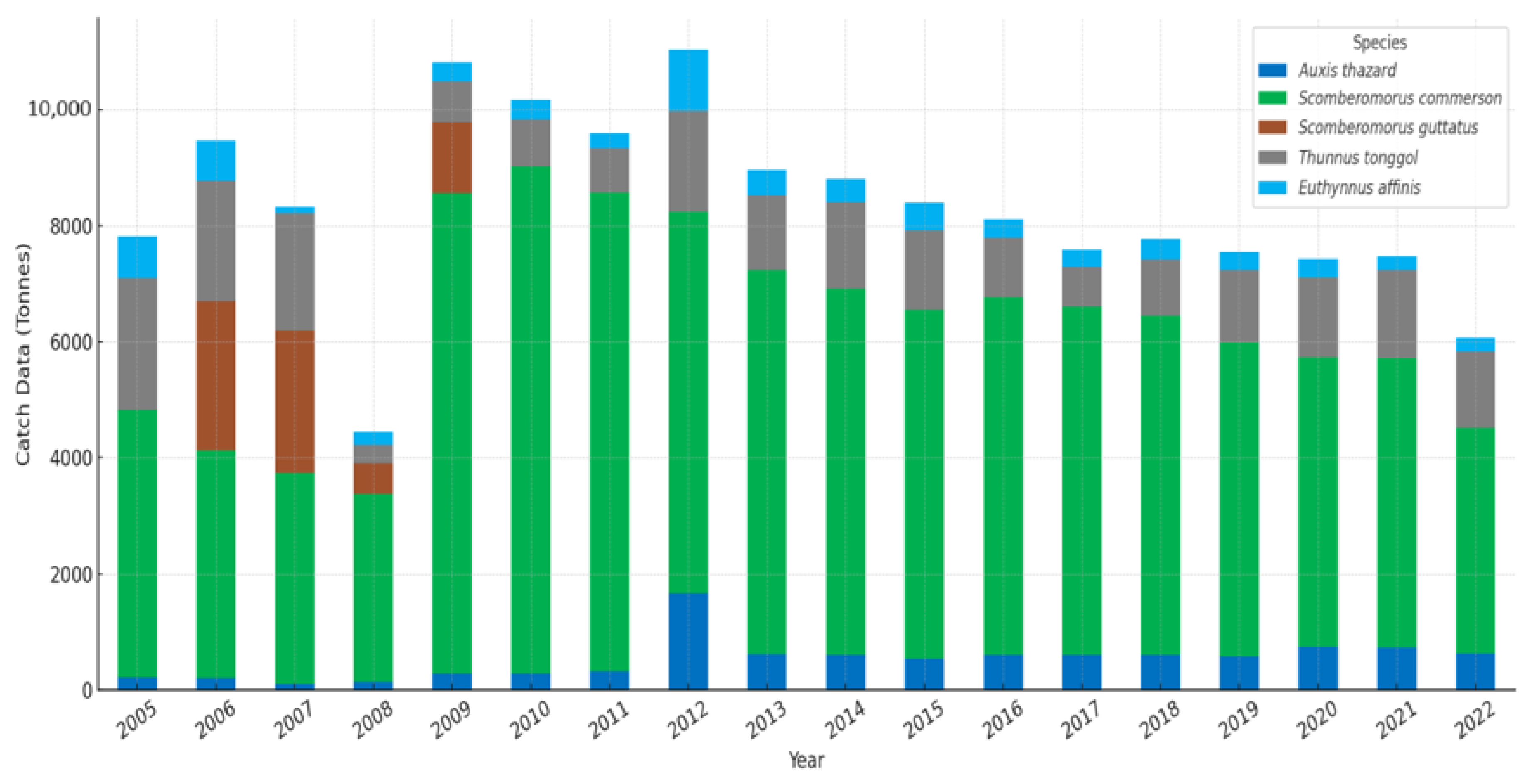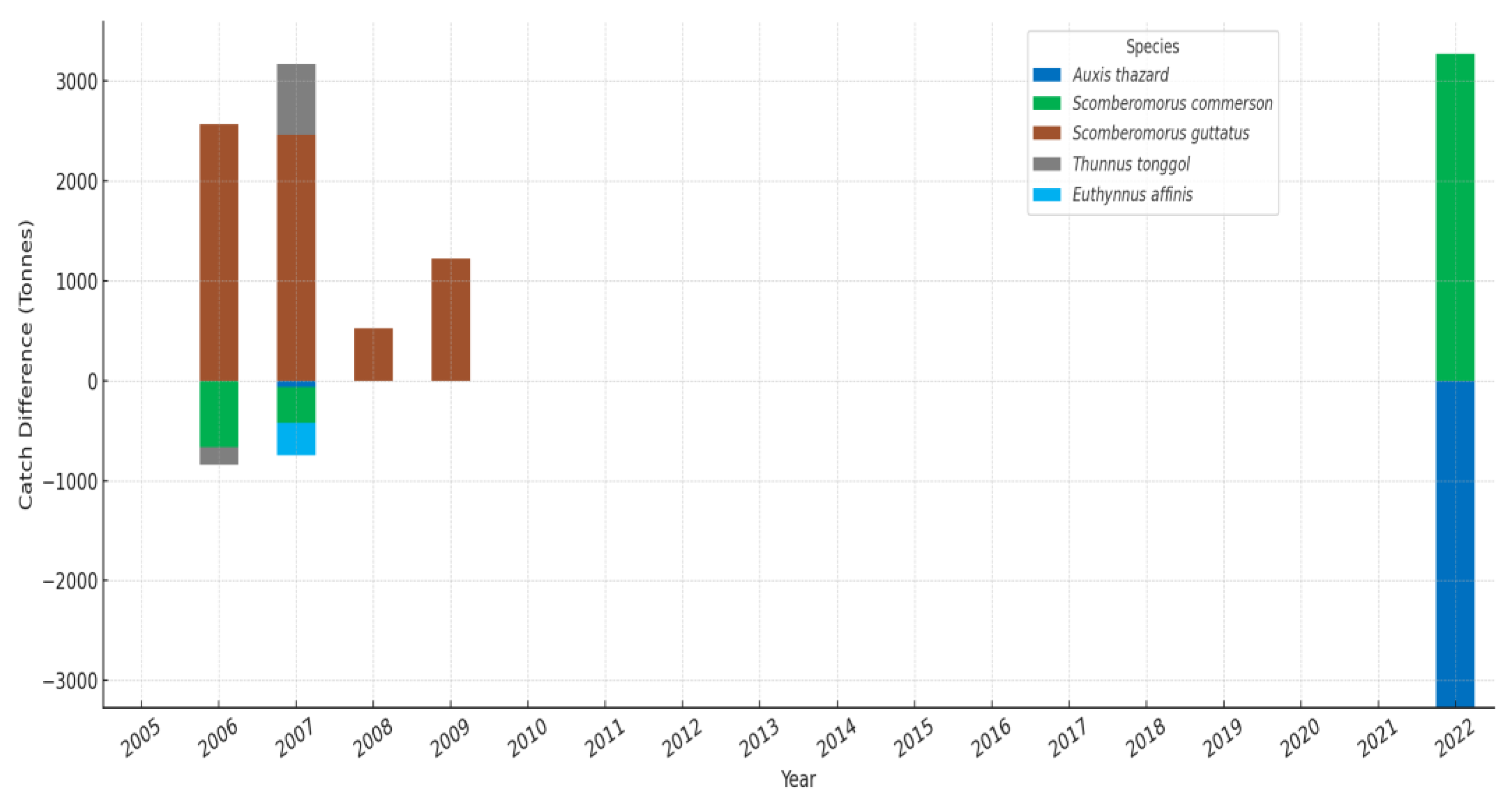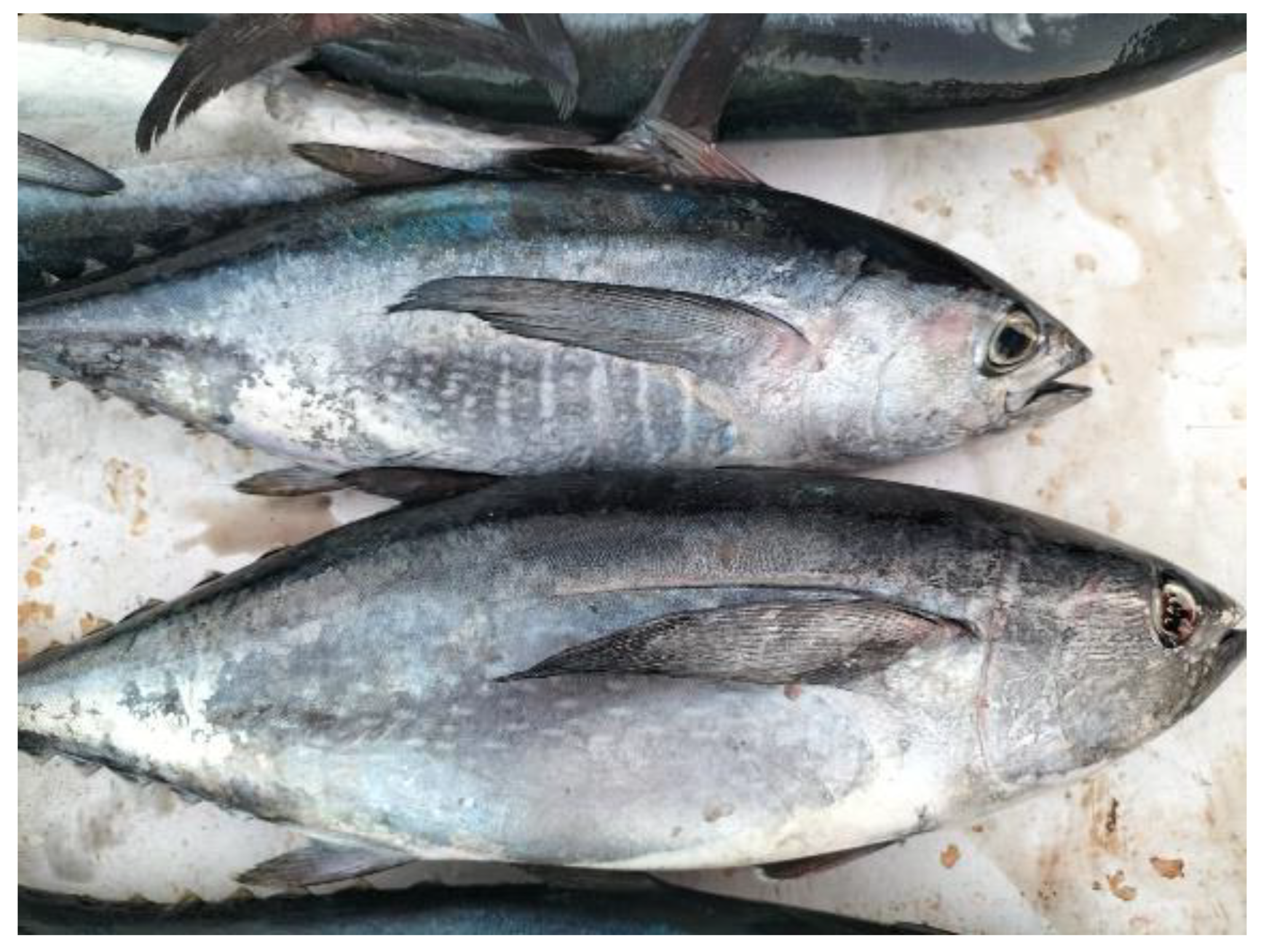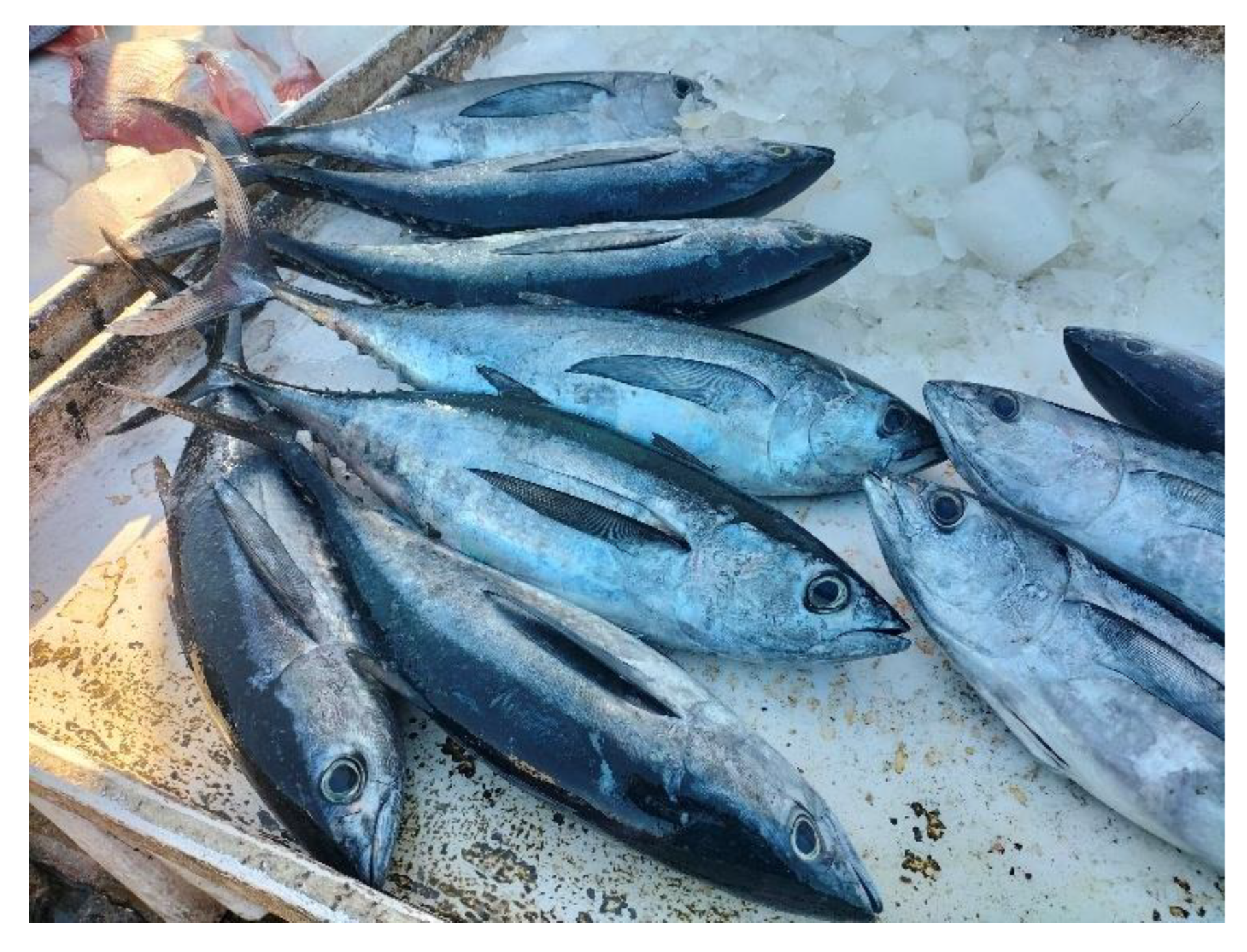Contributing to Responsible Tuna Management in the Indian Ocean: Updating Catch Reporting for the Sea of Oman and the Arabian Sea
Abstract
1. Introduction
2. Misidentification and Database Management in Documenting and Reporting Yellowfin Tuna Catches
2.1. Misidentification
2.2. Reporting Anomalies
2.3. Database Management Issues
2.4. Overall Implications of Incorrect Data for Fisheries Management
3. Yellowfin Tuna in the Indian Ocean and the Arabian Sea
3.1. Population Structures
3.2. Specific Management Implications
3.3. Documentation of Yellowfin Tuna in UAE
3.4. Challenges in Distinguishing Yellowfin and Longtail Tuna
3.5. Reporting Anomalies and Misidentification of Yellowfin and Longtail Tuna
4. An Attempt at Yellowfin Tuna Catches Reconstruction in the UAE
4.1. Data Collection Methods for Fisheries and Catch Estimation
- Field Observations
- b.
- Secondary Data Sources
4.2. Findings
4.3. Catch Data Reconstruction for Yellowfin and Skipjack Tuna
4.4. Improving Accuracy in Statistics of Tuna and Tuna-like Species
5. Legal and Regulatory Implications of Ensuring Correct Identification and Reporting
- (a)
- by having the appropriate correction made in the text and causing the correction to be initialed by duly authorized representatives;
- (b)
- by executing or exchanging an instrument or instruments setting out the correction which it has been agreed to make; or
- (c)
- by executing a corrected text of the whole treaty by the same procedure as in the case of the original text.
- (a)
- engagement in war or other military conflicts;
- (b)
- engagement in civil conflicts;
- (c)
- wide spread piracy in the fishing area;
- (d)
- environmental disasters, such as a tsunami;
- (e)
- spatio-temporal impacts of climate change on fishing once adequate and stable indicators are adopted by the Commission based on advice from the Scientific Committee; and
- (f)
- global pandemic, which have directly affected the fishing capacity of CPC.
6. Conclusions
Author Contributions
Funding
Institutional Review Board Statement
Informed Consent Statement
Data Availability Statement
Acknowledgments
Conflicts of Interest
Abbreviations
| FAO | Food and Agriculture Organisation of the United Nations |
| IOTC | Indian Ocean Tuna Commission |
| RFMO | Regional Fisheries Management Organisation |
Appendix A
Appendix A.1. Results
Appendix B
- Key external diagnostics (fresh specimens): the most visible and reliable features that allow recognition of each species in the field.
- Frequent confusions: the species with which misidentification commonly occurs.
- Quick separations: practical guidelines for distinguishing between similar species, focusing on easily observable external traits.
| Species | Key External Diagnostics (Fresh) | Frequent Confusions | Quick Separations |
| Thunnus albacares (Yellowfin) | white/silver body markings in regularly spaced, vertical lines and alternating lines of spots in a ‘chevron’ pattern (vs. horizontal rows of white/silver elongate spots on belly) [3,14,74] | Longtail | vs Longtail: longtail shows rows of pale oval spots on lower sides; YFT belly has regularly spaced, vertical lines [3,14,74,75] |
| Thunnus tonggol (Longtail) | Elongate, pale/colorless oval spots along lower sides in horizontal rows [3,14,74,75] | Small Yellowfin; kawakawa | Spots are pale/oval (longtail) vs. regularly spaced, vertical lines and alternating lines of spots (YFT) vs. bold belly dark spots (kawakawa) [3,14,74,75]. |
| Katsuwonus pelamis (Skipjack) | 4–6 bold dark longitudinal bands on lower sides/belly; pectorals short [3,14,74,76]. | Kawakawa | Skipjack = long bands (not just spots). Kawakawa shows discrete dark belly spots between pectoral & pelvic fins [3,14,74,76,77]. |
| Euthynnus affinis (Kawakawa) | Several dark spots between pectoral and pelvic fins; back with complex striping that doesn’t extend far forward of 1st dorsal mid-base; pectorals short [3,14,74,77]. | Skipjack; longtail | Belly spots (kawakawa) vs. bands (skipjack) vs. pale oval spots (longtail) [3,14,74,76,77]. |
References
- Pillai, N.G.; Satheeshkumar, P. Biology, Fishery, Conservation and Management of Indian Ocean Tuna Fisheries. Ocean. Sci. J. 2012, 47, 411–433. [Google Scholar] [CrossRef]
- Yadav, S.; Abdulla, A.; Bertz, N.; Mawyer, A. King tuna: Indian Ocean trade, offshore fishing, and coral reef resilience in the Maldives archipelago. ICES J. Mar. Sci. 2020, 77, 398–407. [Google Scholar] [CrossRef]
- Collette, B.B.; Nauen, C.E. FAO Species Catalogue Vol. 2—Scombrids of the World: An Annotated and Illustrated Catalogue of Tunas, Mackerels, Bonitos and Related Species Known to Date; FAO: Rome, Italy, 1983. [Google Scholar]
- Parsa, M.; Kamrani, E.; Safaei, M.; Paighambari, S.Y.; Nishida, T. Identification of by-catch species of tuna purse seiners in Iranian waters of Oman Sea. Iran. J. Fish. Sci. 2018, 17, 239–244. [Google Scholar] [CrossRef]
- EAD. Abu Dhabi Fisheries & Aquaculture Bulletin: Fisheries and Aquaculture Production in the Emirate of Abu Dhabi; Environment Agency: Abu Dhabi, United Arab Emirates, 2018. [Google Scholar]
- EAD. The State of Abu Dhabi Fisheries and Aquaculture 2023-Balancing Science, Conservation and Impactful Decisions; Environment Agency: Abu Dhabi, United Arab Emirates, 2024. [Google Scholar]
- Lyon, J.P.; Tonkin, Z.; Moloney, P.D.; Todd, C.; Nicol, S. Conservation implications of angler misidentification of an endangered fish. Aquatic Conserv. Mar. Freshw. Ecosyst. 2018, 28, 1396–1402. [Google Scholar] [CrossRef]
- Tillett, B.J.; Field, I.C.; Bradshaw, C.J.A.; Johnson, G.; Buckworth, R.C.; Meekan, M.G.; Ovenden, J.R. Accuracy of species identification by fisheries observers in a north Australian shark fishery. Fish. Res. 2012, 127–128, 109–115. [Google Scholar] [CrossRef]
- Thys, K.J.M.; Lemey, L.; Bogaert, N.V. Blondes do it better? A comparative study on the morphometry and life-history traits of commercially important skates blonde ray Raja brachyura, thornback ray Raja clavata, and spotted ray Raja montagui, with management implications. Fish. Res. 2023, 263, 106679. [Google Scholar] [CrossRef]
- Lowenstein, J.H.; Amato, G.; Kolokotronis, S.-O. The Real maccoyii: Identifying Tuna Sushi with DNA Barcodes–Contrasting Characteristic Attributes and Genetic Distances. PLoS ONE 2009, 4, e7866. [Google Scholar] [CrossRef]
- Grewe, P.M. An Assessment of Bigeye (Thunnus obesus) Population Structure in the Pacific Ocean, Based on Mitochondrial DNA and DNA Microsatellite Analysis. In Proceedings of the 7th Meeting of the Western Pacific Yellowfin Tuna Research Group, Nadi, Fiji, 18–20 June 1997; Available online: https://www.fish.gov.au/Archived-Reports/2014/Documents/Grewe_and_Hampton_1998.pdf (accessed on 10 June 2025).
- Itano, D.G.; Williams, P.G. Review of Bigeye and Yellowfin Tuna Catches Landed in Palawan, Philippines; Western and Central Pacific Fisheries Commission (WCFPC): Kolonia, Micronesia, 2009. [Google Scholar]
- Itano, D.G. Handbook for the Identification of Yellowfin and Bigeye Tunas in Brine Frozen Condition (v5, Originally submitted as v4). In Proceedings of the 17th Meeting of the Standing Committee on Tuna and Billfish, Majuro, Marshall Islands, 9–18 August 2004. Fishing Technology Working Group INF-FTWG: 5 August 2004. [Google Scholar]
- Yuniarta, S.; Satrioajie, W.N. Species ID Guide for Tuna Fisheries in Indonesian Archipelagic Waters. YKAN Technical Paper January 20, 2023, Yayasan Konservasi Alam Nusantara and People and Nature Consulting International. Available online: http://72.14.187.103:8080/ifish/pub/TunaSpeciesID.pdf (accessed on 10 June 2025).
- Nakamura, I. Big Catches of Longtail Tuna in Wakasa Bay, Japan Sea. Jpn. J. Ichthyol. 1969, 15, 160–161. [Google Scholar]
- Mohri, M.; Kajikawa, Y. Ecology of bluefin tuna and longtail tuna in the Sea of Japan based on mathematical and physical fisheries science consideration using chi-square test, cluster analysis, and linear discriminant analysis. Math. Phys. Fish. Sci. 2014, 11, 22–42. [Google Scholar]
- Astarini, I.A.; Ningsih, E.Y.; Simanungkalit, D.; Ardiana, S.A.; Al Malik, M.D.; Yusmalinda, N.L.A.; Sembiring, A.; Pertiwi, N.P.D.; Cahyani, N.K.D.; Collins, A. Genetic variation of longtail tuna Thunnus tonggol landed in four fish markets in Indonesia based on mitochondrial DNA. Biodiversitas J. Biol. Divers. 2021, 22, 1644–1651. [Google Scholar] [CrossRef]
- Yesaki, M. A review of the biology and fisheries for longtail tuna (Thunnus tonggol) in the Indo-Pacific region. In Interactions of Pacific Tuna Fisheries, Proceedings of the first FAO Expert Consultation on Interactions of Pacific Tuna Fisheries, Noumea, New Caledonia, 3–11 December 1991; Volume 2: Papers on Biology and Fisheries; FAO Fisheries Technical Paper. No. 336, Vol. 2; Shomura, R.S., Majkowski, J., Langi, S., Eds.; FAO: Rome, Italy, 1993; 439p. [Google Scholar]
- Kunal, S.P.; Kumar, G. Cytochrome Oxidase I (COI) sequence conservation and variation patterns in the yellowfin and longtail tunas. Int. J. Bioinform. Res. Appl. 2013, 9, 301–309. [Google Scholar] [CrossRef]
- Durand, J.D.; Collet, A.; Chow, S.; Borsa, P. Molecular systematics and phylogeography of Atlantic and Indo-Pacific yellowfin tuna. Fish. Res. 2015, 90, 15–24. [Google Scholar]
- Itano, D. The Reproductive Biology of Yellowfin Tuna (Thunnus albacares) in Hawaiian Waters and the Western Tropical Pacific Ocean: Project Summary; University of Hawaii, JIMAR Contribution 00-328, SOEST 00-01, 2000. Available online: https://www.soest.hawaii.edu/pfrp/biology/itano/itano_yft.pdf (accessed on 21 February 2025).
- FAO. Identification Guide to Tuna Species of Commercial Importance; FAO Fisheries Technical Paper No. 568; FAO: Rome, Italy, 2011. [Google Scholar]
- McPherson, G.R. Comparative growth and mortality rates of Yellowfin and Longtail tuna off northern Australia. Aust. Fish. J. 1988, 10, 77–85. [Google Scholar]
- Mardlijah, S.; Kurniawan, R.; Setyohadi, D. Growth pattern comparison of Thunnus albacares and Thunnus tonggol in Java Sea. Indones. Fish. Res. J. 2012, 18, 45–59. [Google Scholar]
- Tsimenides, N.; Tserpes, G.; Papaconstantinou, C. Coloration and post-mortem changes in small tuna species: A field guide approach. Mediterr. Mar. Sci. J. 1992, 17, 201–212. [Google Scholar]
- Chen, K.; Sun, C.; Yeh, S.; Chiang, W. Identification of tuna species in the Pacific using morphological and molecular methods. J. Mar. Sci. 2017, 34, 215–230. [Google Scholar]
- Ward, R.D.; Zemlak, T.S.; Innes, B.H.; Last, P.R.; Hebert, P.D. DNA barcoding Australia's fish species. Philos. Trans. R. Soc. B Biol. Sci. 2005, 360, 1847–1857. [Google Scholar] [CrossRef]
- Kumar, G.; Kumar, R.; Gupta, S. A comparative study of meristic characteristics in Yellowfin and Longtail tuna from Indian waters. Indian J. Fish. Sci. 2015, 62, 143–152. [Google Scholar]
- Hidayat, T.; Boer, M.; Kamal, M.M.; Zairion; Suman, A. Morfometric Character of Longtail Tuna (Thunnus tonggol). IOP Conf. Ser. Earth Environ. Sci. 2023, 1224, 012013. [Google Scholar] [CrossRef]
- Somvanshi, V.S.; Varghese, S.; Bhargava, A.K.; Varghese, S.P. Comparison of growth parameters of yellowfin tuna caught from Arabian Sea and Bay of Bengal. In Proceedings of the Indian Ocean Tuna Commission Working Party on Tropical Tunas, Victoria, Seychelles, 13–21 July 2004. [Google Scholar]
- Herrera, M. Catches of Artisanal and Industrial Fleets in Indonesia: An Update; WPTT02-02 IOTC Proceedings no. 5; FAO: Rome, Italy, 2002; pp. 105–124. [Google Scholar]
- Pertiwi, N.P.D.; Al Malik, M.D.; Sembiring, A.; Yusmalinda, N.L.A.; Ningsih, E.Y.; Cahyani, N.K.D.; Khairul, A.W.A.; Rahim, A.A.; Meyer, C.; Collette, B.; et al. Population structure of longtail tuna (Thunnus tonggol) within and across Indonesia’s fisheries management areas (FMAs) and neighboring countries based on mitochondrial control region. Reg. Stud. Mar. Sci. 2024, 78, 103778. [Google Scholar] [CrossRef]
- Le Gallic, B.; Cox, A. An economic analysis of illegal, unreported and unregulated (IUU) fishing: Key drivers and possible solutions. Mar. Policy 2006, 30, 689–695. [Google Scholar] [CrossRef]
- MRAG Asia Pacific. The Quantification of Illegal, Unreported and Unregulated (IUU) Fishing in the Pacific Islands Region—A 2020 Update; MRAG Asia Pacific: Brisbane, QLD, Australia, 2021; 125p. [Google Scholar]
- Wilcox, C.; Mann, V.; Cannard, T.; Ford, J.; Hoshino, E.; Pascoe, S. A Review of Illegal, Unreported and Unregulated Fishing Issues and Progress in the Asia-Pacific Fishery Commission Region; CSIRO, FAO and Hobart: Bangkok, Thailand, 2021. [Google Scholar] [CrossRef]
- Leadbitter, D.; Sadovy de Mitcheson, Y.; Macfarlane, N.B.W. Unselective, Unsustainable, and Unmonitored Trawl Fisheries? Situation Analysis with Case Studies from Southeast and East Asia; IUCN: Gland, Switzerland, 2024. [Google Scholar]
- Polacheck, T. Assessment of IUU fishing for Southern Bluefin Tuna. Mar. Policy 2012, 36, 1150–1165. [Google Scholar] [CrossRef]
- Martin, S. Alternative Methods to Improve Data Collection in IOTC Coastal Fisheries: Progress, Pitfalls and Priorities; IOTC-2023-WPDCS19-13 Rev_1; IOTC Secretariat: Mahe, Seychelles, 2023. [Google Scholar]
- Anderson, R.C.; Hafiz, A. Status of tuna research and data collection in the Maldives. In Proceedings of the 6th Session of Expert Consultation on Indian Ocean Tunas, Colombo, Sri Lanka, 25–29 September 1995. [Google Scholar]
- Yuniarta, S.; van Zwieten, P.A.; Groeneveld, R.A.; Wisudo, S.H.; Ierland, E.C. Uncertainty in catch and effort data of small- and medium-scale tuna fisheries in Indonesia: Sources, operational causes and magnitude. Fish. Res. 2017, 193, 173–183. [Google Scholar] [CrossRef]
- Grantham, A.; Pandan, M.R.; Roxas, S.; Hitchcock, B. Overcoming Catch Data Collection Challenges and Traceability Implementation Barriers in a Sustainable, Small-Scale Fishery. Sustainability 2022, 14, 1179. [Google Scholar] [CrossRef]
- Rudd, M.B.; Branch, T.A. Does unreported catch lead to overfishing? Fish Fish. 2017, 18, 313–323. [Google Scholar] [CrossRef]
- Juan, A.P.S.; Alonso, M.L.R.; Sierra, V.; Báez, J.C. Undetected silky sharks (Carcharhinus falciformis) in the wells of the tropical tuna purse seine fleet in the Indian Ocean. Fish. Res. 2024, 278, 107109. [Google Scholar] [CrossRef]
- Willette, D.A.; Santos, M.D. Correcting widespread misidentifications of the highly abundant and commercially important sardine species Sardinella lemuru, Bleeker, 1853 in the Philippines. J. Appl. Ichthyol. 2013, 29, 881–885. [Google Scholar] [CrossRef]
- Chang, C.-H.; Kao, Y.-T.; Huang, T.-T.; Wang, Y.-C. Product Authentication Using Two Mitochondrial Markers Reveals Inconsistent Labeling and Substitution of Canned Tuna Products in the Taiwanese Market. Foods 2021, 10, 2655. [Google Scholar] [CrossRef]
- Pardo, M.A.; Jiménez, E.; Pérez-Villarreal, B. Misdescription incidents in seafood sector. Food Control. 2016, 62, 277–283. [Google Scholar] [CrossRef]
- Garcia-Vazquez, E.; Machado-Schiaffino, G.; Campo, D.; Juanes, F. Species misidentification in mixed hake fisheries may lead to overexploitation and population bottlenecks. Fish. Res. 2012, 114, 52–55. [Google Scholar] [CrossRef]
- Miyabe, N.; Barüt, N.; Chow, S. Species Identification of small juvenile tunas caught in surface fisheries in the Philippines. In Status of Interactions of Pacific Tuna Fisheries, Proceedings of the Second FAO Expert Consultation Interactions of Pacific Tuna Fisheries, Shimizu, Japan, 23–31 January 1995; Shomura, R.S., Majkowski, J., Harman, R.F., Eds.; FAO Fisheries Technical Paper. No. 365; FAO: Rome, Italy, 1996; 612p. [Google Scholar]
- Barut, N.C.; Garvilles, E.G. Philippine annual fishery report update. Annual Report—Part 1 Information on Fisheries, Research, and Statistics WCPFC-SC4-AR PART 1/WP-24. In Proceedings of the Scientific Committee Fourth Regular Session, Port Moresby, Papua New Guinea, 11–22 August 2008. [Google Scholar]
- Pedrosa-Gerasmio, I.R.; Babaran, R.P.; Santos, M.D. Discrimination of Juvenile Yellowfin (Thunnus albacares) and Bigeye (T. obesus) Tunas using Mitochondrial DNA Control Region and Liver Morphology. PLoS ONE 2012, 7, e35604. [Google Scholar] [CrossRef]
- Blanco-Fernandez, C.; Erzini, K.; Rodriguez-Diego, S.; Alba-Gonzalez, P.; Thiam, N.; Sow, F.N.; Diallo, M.; Viðarsson, J.R.; Fernández-Vidal, D.; Gonçalves, J.M.S.; et al. Two Fish in a Pod. Mislabelling on Board Threatens Sustainability in Mixed Fisheries. Front. Mar. Sci. 2022, 9, 841667. [Google Scholar] [CrossRef]
- Pecoraro, C.; Zudaire, I.; Bodin, N.; Murua, H.; Taconet, P.; Dı´az-Jaimes, P.; Cariani, A.; Tinti, F.; Chassot, E. Putting all the pieces together: Integrating current knowledge of the biology, ecology, fisheries status, stock structure and management of yellowfin tuna (Thunnus albacares). Rev. Fish. Biol. Fish. 2017, 27, 811–841. [Google Scholar] [CrossRef]
- Griffiths, S.; Leadbitter, D.; Willette, D.; Kaymaram, F.; Moazzam, M. Longtail tuna, Thunnus tonggol (Bleeker, 1851): A global review of population dynamics, ecology, fisheries, and considerations for future conservation and management. Rev. Fish. Biol. Fish. 2020, 30, 25–66. [Google Scholar] [CrossRef]
- Aguila, R.D.; Perez, S.K.L.; Catacutan, B.J.N.; Lopez, G.V.; Barut, N.C.; Santos, M.D. Correction: Distinct Yellowfin Tuna (Thunnus albacares) Stocks Detected in Western and Central Pacific Ocean (WCPO) Using DNA Microsatellites. PLoS ONE 2015, 10, e0144568. [Google Scholar] [CrossRef]
- Feutry, P.; Foster, S.; Grewe, P.; Aulich, J.; Lansdell, M. Genetic Population Structure of Neritic Tunas in the Indian Ocean from the PSTBS-IO Project. In Proceedings of the 10th Meeting of the Working Party of Neritic Tuna, 2020; IOTC-2020-WPNT10-10. Available online: https://publications.csiro.au/publications/publication/PIcsiro:EP2021-1703 (accessed on 10 June 2025).
- Davies, C.; Marsac, F.; Murua, H.; Fahmi, Z.; Fraile, I. Summary of population structure of IOTC species from PSTBS-IO project and recommended priorities for future work. In Proceedings of the Scientific Committee, Seventeenth Regular Session, Online, 11–19 August 2021. WCPFC-SC17-2021/SA-IP-13. [Google Scholar]
- Dammannagoda, S.T.; Hurwood, D.A.; Peter, B.M. Evidence for fine geographical scale heterogeneity in gene frequencies in yellowfin tuna (Thunnus albacares) from the north Indian Ocean around Sri Lanka. Fish. Res. 2008, 90, 147–157. [Google Scholar] [CrossRef][Green Version]
- Abdussamad, E.M.; Surya, S.; Koya, K.P.S.; Rohit, P.; Abbas, A.M.; Prakasan DIsmail, S. Population characteristics unravel occurrence of distinct stocks of yellowfin tuna (Thunnus albacares) population in the Indian seas. Indian J. Fish. 2024, 71, 144–149. [Google Scholar] [CrossRef]
- Eighani, M.; Cope, J.M.; Raoufi, P.; Naderi, R.A.; Bach, P. Understanding fishery interactions and stock trajectory of yellowfin tuna exploited by Iranian fisheries in the Sea of Oman. ICES J. Mar. Sci. 2021, 78, 2420–2431. [Google Scholar] [CrossRef]
- Kaymaram, F.; Hosseini, S.A.; Darvishi, M.; Parafkandeh, F. Estimates of Length-Based Population Parameters of Yellowfin tuna (Thunnus albacares) in the Oman Sea. Turk. J. Fish. Aquat. Sci. 2014, 14, 101–111. [Google Scholar] [CrossRef]
- Fraile, I.; Murua, H.; Zudaire, I.; Arrizabalaga, H.; Rooker, J. Discrimination of Yellowfin tuna from the Putative Nurseries of the Western Indian Ocean; IOTC–2013–WPTT15–36; FAO: Rome, Italy, 2013. [Google Scholar]
- Artetxe-Arrate, I.; Fraile, I.; Farley, J.; Darnaude, A.M.; Clear, N.; Dettman, D.L.; Davies, C.; Marsac, F.; Murua, H. Otolith δ18O as a Tracer of Yellowfin tuna (Thunnus albacares) Nursery Origin in the Indian Ocean; IOTC-2020-WPTT22(AS)-06_Rev1; FAO: Rome, Italy, 2020. [Google Scholar]
- Artetxe-Arrate, I.; Fraile, I.; Clear, N.; Darnaude, A.M.; Dettman, D.; Pécheyran, C.; Farley, J.; Murua, H. Discrimination of yellowfin tuna Thunnus albacares between nursery areas in the Indian Ocean using otolith chemistry. Mar. Ecol. Prog. Ser. 2021, 673, 165–181. [Google Scholar] [CrossRef]
- Varghese, S.P.; Mukesh Pandey, S.; Ramalingam, L. Recent Studies on the Population Delineation of Yellowfin Tuna in the Indian Ocean—Considerations for Stock Assessment; IOTC-2019-WPM10-18; FAO: Rome, Italy, 2019. [Google Scholar]
- Kerr, L.A.; Hintzen, N.T.; Cadrin, S.X.; Clausen, L.; Worsøe Dickey-Collas, M.; Goethel, D.R.; Hatfield, E.M.C.; Kritzer, J.P.; Nash, R.D.M. Lessons learned from practical approaches to reconcile mismatches between biological population structure and stock units of marine fish. ICES J. Mar. Sci. 2017, 74, 1708–1722. [Google Scholar] [CrossRef]
- Kolody, D.; Peter Grewe, P.; Davies, C.; Proctor, C. Are Indian Ocean Tuna Populations Assessed and Managed at the Appropriate Spatial Scale? A Brief Review of the Evidence and Implications; Indian Ocean Tuna Commission Working Party on Tropical Tuna 2013 Working Paper, IOTC-2013-WPTT-15-13; FAO: Rome, Italy, 2013. [Google Scholar]
- Grewe, P.M.; Feutry, P.; Hill, P.; Gunasekera, R.; Schaefer, K.M.; Itano, D.; Fuller, D.W.; Foster, S.; Davies, C.R. Evidence of discrete yellowfin tuna (Thunnus albacares) populations demands rethink of management for this globally important resource. Sci. Rep. 2015, 5, 16916. [Google Scholar] [CrossRef] [PubMed]
- Grewe, P.; Feutry, P.; Foster, S.; Aulich, J.; Lansdell, M. Genetic Population Connectivity of Yellowfin Tuna in the Indian Ocean from the PSTBS-IO Project; IOTC-2020-WPTT22(AS)12_REV1.2020; FAO: Rome, Italy, 2020. [Google Scholar]
- ESRI. ArcGIS Pro, version 3.3.1; Environmental Systems Research Institute: Redlands, CA, USA, 2025. [Google Scholar]
- Pinello, D.; Gee, J.; Dimech, M. Handbook for Fisheries Socio-Economic Sample Survey—Principles and Sractice; FAO Fisheries and Aquaculture Technical Paper No. 613; FAO: Rome, Italy, 2017. [Google Scholar]
- Amarasinghe, U.S.; De Silva, S.S.; Nguyen, T.T.T. Fisheries in Sri Lanka: Current status and challenges for future development. Aquat. Ecosyst. Health Manag. 2011, 14, 231–241. [Google Scholar]
- Sari, R.N.; Widodo, W.; Purwanto, H. The impact of mixed-species catches on fisheries management in Indonesia. J. Fish. Sci. 2020, 36, 455–464. [Google Scholar]
- Indian Ocean Tuna Commission (IOTC). IOTC Regional Observer Scheme Manual. IOTC, Seychelles. 2022. Available online: https://openknowledge.fao.org/server/api/core/bitstreams/0b786ee1-ac69-42f0-bf5c-7b08679eaafb/content (accessed on 10 June 2025).
- FishIDER. Guide to Scombridae. Available online: https://fishider.org/en/guide/osteichthyes/scombridae (accessed on 20 August 2025).
- Bray, D.J.; Schultz, S. Thunnus Tonggol in Fishes of Australia. 2022. Available online: https://fishesofaustralia.net.au/home/species/734 (accessed on 20 August 2025).
- Fishes of Australia. Katsuwonus. Available online: https://fishesofaustralia.net.au/home/genus/736 (accessed on 20 August 2025).
- Fishes of Australia. Euthynnus. Available online: https://fishesofaustralia.net.au/home/genus/529 (accessed on 20 August 2025).










| Commercial Fishers | Traders | Recreational Fishers & Charter Boats | |
|---|---|---|---|
| Total interviews | 71 | 22 | 43 |
| Tot Boats | Kg per Boat/Trip | Trip per Boat/Season | Tonnes/Boat/Season | Total Catch (Tonnes) |
|---|---|---|---|---|
| 369 | 142 | 46 | 6.6 | 2424 |
| Tot Boats | Kg per Boat/Trip | Trip per Boat/Season | Tonnes/Boat/Season | Total Catch (Tonnes) |
|---|---|---|---|---|
| 369 | 14 | 46 | 0.7 | 242 |
| Species Name | 2018 | 2019 | 2020 | 2021 | 2022 |
|---|---|---|---|---|---|
| Thunnus tonggol—OLD | 971 | 1250 | 1384 | 1517 | 1318 |
| Thunnus tonggol—NEW * | 922 | 1188 | 1315 | 1441 | 1252 |
| Thunnus albacares— NEW ** | 2473 | 2487 | 2493 | 2500 | 2490 |
| Katsuwonus pelamis—NEW *** | 247 | 249 | 249 | 250 | 249 |
Disclaimer/Publisher’s Note: The statements, opinions and data contained in all publications are solely those of the individual author(s) and contributor(s) and not of MDPI and/or the editor(s). MDPI and/or the editor(s) disclaim responsibility for any injury to people or property resulting from any ideas, methods, instructions or products referred to in the content. |
© 2025 by the authors. Licensee MDPI, Basel, Switzerland. This article is an open access article distributed under the terms and conditions of the Creative Commons Attribution (CC BY) license (https://creativecommons.org/licenses/by/4.0/).
Share and Cite
Pinello, D.; Alhashmi, A.E.A.; Ferri, N.; Leadbitter, D.; Al Marzooqi, M.H.A.; Almusallami, M.A.A.; Al Ali, S.R.; Al Hameli, S.M.; Francis, F.; Al Dhaheri, S.S. Contributing to Responsible Tuna Management in the Indian Ocean: Updating Catch Reporting for the Sea of Oman and the Arabian Sea. Sustainability 2025, 17, 7889. https://doi.org/10.3390/su17177889
Pinello D, Alhashmi AEA, Ferri N, Leadbitter D, Al Marzooqi MHA, Almusallami MAA, Al Ali SR, Al Hameli SM, Francis F, Al Dhaheri SS. Contributing to Responsible Tuna Management in the Indian Ocean: Updating Catch Reporting for the Sea of Oman and the Arabian Sea. Sustainability. 2025; 17(17):7889. https://doi.org/10.3390/su17177889
Chicago/Turabian StylePinello, Dario, Ahmed Esmaeil Alsayed Alhashmi, Nicola Ferri, Duncan Leadbitter, Mohamed Hasan Ali Al Marzooqi, Mohamed Abdulla Ahmed Almusallami, Sultan Rashed Al Ali, Shamsa Mohamed Al Hameli, Franklin Francis, and Shaikha Salem Al Dhaheri. 2025. "Contributing to Responsible Tuna Management in the Indian Ocean: Updating Catch Reporting for the Sea of Oman and the Arabian Sea" Sustainability 17, no. 17: 7889. https://doi.org/10.3390/su17177889
APA StylePinello, D., Alhashmi, A. E. A., Ferri, N., Leadbitter, D., Al Marzooqi, M. H. A., Almusallami, M. A. A., Al Ali, S. R., Al Hameli, S. M., Francis, F., & Al Dhaheri, S. S. (2025). Contributing to Responsible Tuna Management in the Indian Ocean: Updating Catch Reporting for the Sea of Oman and the Arabian Sea. Sustainability, 17(17), 7889. https://doi.org/10.3390/su17177889






